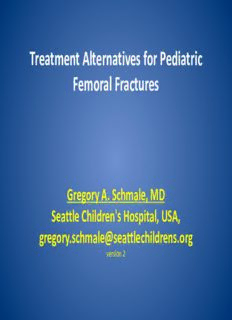
Pediatric diaphyseal femur fracture PDF
Preview Pediatric diaphyseal femur fracture
Treatment Alternatives for Pediatric Femoral Fractures Gregory A. Schmale, MD Seattle Children's Hospital, USA, [email protected] version 2 I have no conflicts of interest to report Seattle Richland Objectives • Briefly review the AAOS evidenced- based Clinical Practice Guideline on diaphyseal femur fractures in children http://www.aaos.org/research/guidelines/PDFFguideline.a sp • Introduce the SIGN Pediatric Nail • Examine the results of treatment of diaphyseal pediatric femur fractures at Seattle Children's Hospital AAOS Guidelines for Treatment of Diaphyseal Femur Fractures in Children • Desirable Treatments minimize the emotional and physical impact of injury. Minimize – duration of immobilization – time out of school • Children younger than 3 years of age should be evaluated for child abuse. AAOS Guidelines for Treatment of Diaphyseal Femur Fractures in Children • Treatment with a Pavlik harness or a spica cast are options for infants six months and younger with a femoral shaft fracture. • For children age six months to five years with less than 2 cm of shortening – early spica casting or traction with delayed spica casting are recommended – Use caution when spica casting for children age 6m – 5yrs with greater than 2 cm of shortening. AAOS Guidelines for Treatment of Diaphyseal Femur Fractures in Children • Flexible intramedullary nailing can be effective in children 5-11yrs. – Patients over age 11 or with weight > 49 kg are at increased risk of a poor outcome with flexible intramedullary nailing. • Options include: • pediatric rigid intramedullary nails • bridge plating for inclusion in the current guideline. Pediatric diaphyseal femur fracture • flexible intramedullary nailing These are titanium nails, also known as a TENs – Titanium Elastic Nails Typically placed retrograde Stainless steel nails preferable over titanium Wall, et al., JBJS Am, 2008: Retrospective case-control study comparing outcomes of Ti vs. stainless steel flexible nail treatment • Malunion rate 4 X higher with Ti vs stainless steel nails • Complication rate 2X higher with Ti nails • Cost of Ti nails 3-4X higher per nail than stainless steel nails Sink, et al., Journal of Pediatric Orthopedics, 2010 Retrospective case-control study • Decreased complications by limiting flexible Ti nail use to femur fractures with stable patterns unstable = comminution, long oblique (fx length > diameter of femur at fx) Potential Complications Flexible Nails • Knee pain at nail insertion site • Fracture shortening • Nail back-out and migration • Nail prominence • Malunion • Delayed union • Refracture after nail removal
Description: